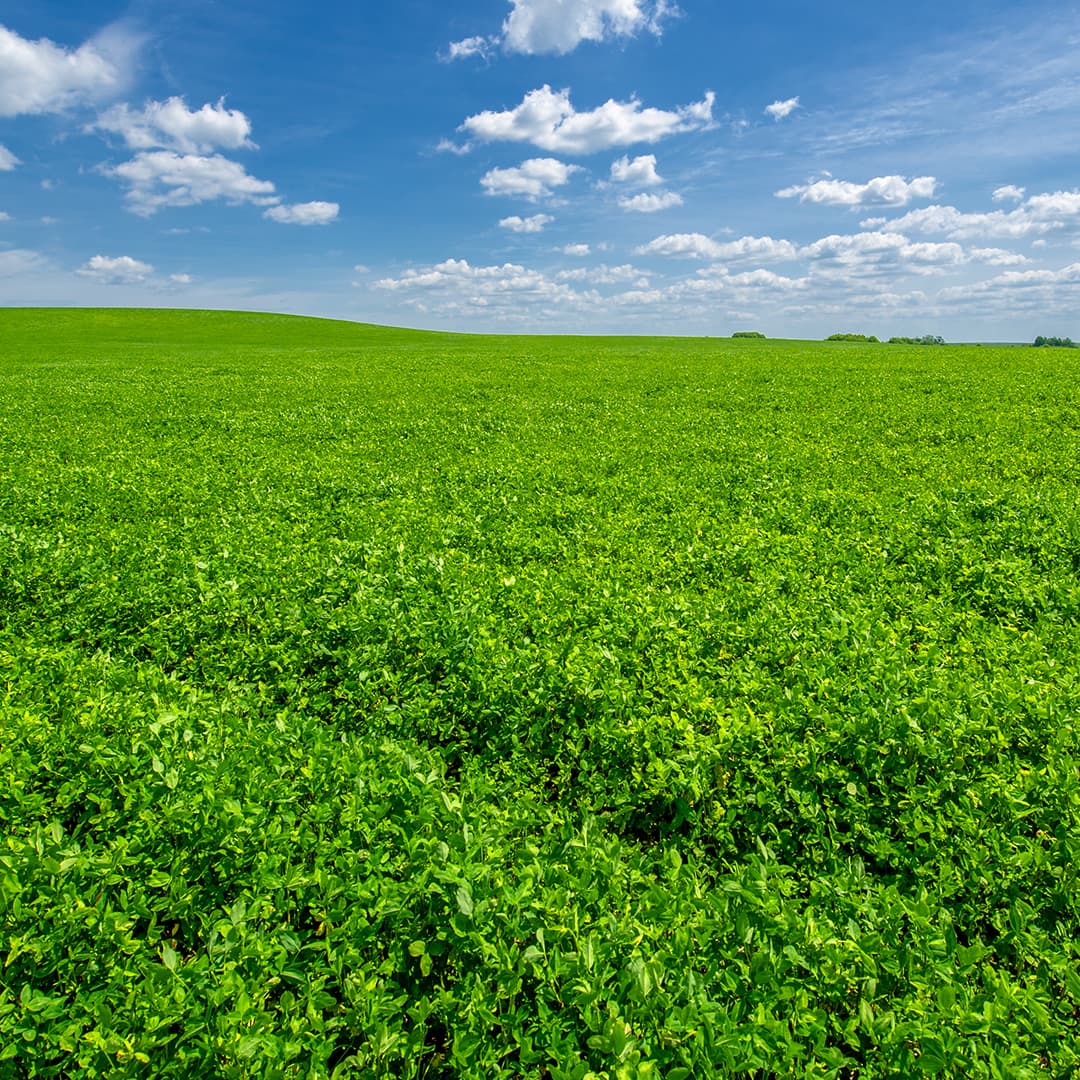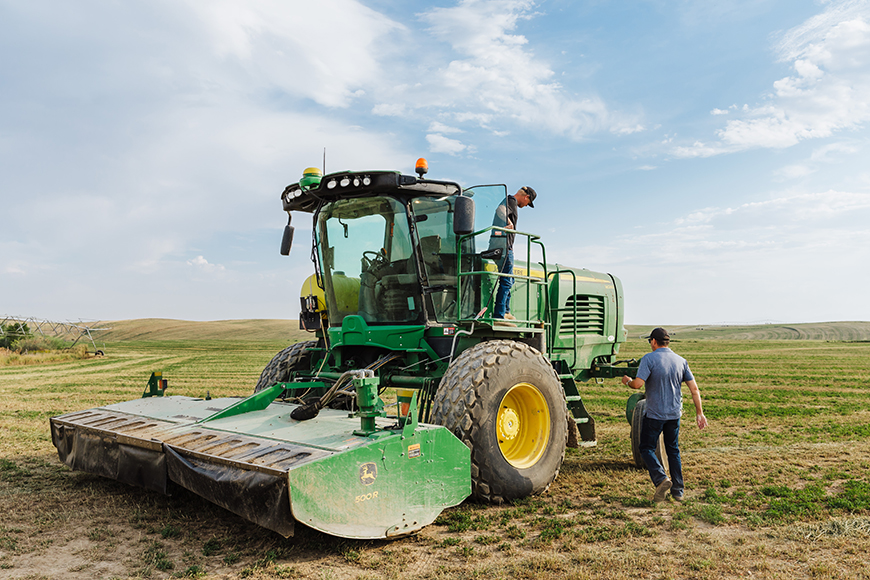Aphanomyces Root Rot: The Race is on to Defend Alfalfa
Once thought of as a wet-soil disease, aphanomyces root rot is more widespread than many realize. It’s also one of the few alfalfa diseases to develop races — genetic variations of the pathogens that challenge established resistant varieties— making it doubly threatening to long-term alfalfa productivity.
While a lack of distinctive characteristics makes aphanomyces difficult to detect, experts believe the disease is responsible for diminished stands across the country.
“Aphanomyces has been identified in all northern alfalfa-growing states and in the nondormant regions of California,” says Dan Undersander, Extension and Research Forage Agronomist, University of Wisconsin.
The scope became obvious as more growers began planting varieties with resistance to the two established races of the disease. “We’ve found that resistant varieties perform better in a wide range of environments, not just in areas with wet soils,” says Mark McCaslin, V.P. Research, Forage Genetics International (FGI). “From the Pacific Northwest to New York state, growers who plant those resistant varieties are seeing yield benefits.”
The fungal plant pathogen Aphanomyces euteiches is responsible for the disease that weakens seedlings and causes root pruning in established plants, dramatically reducing water and nutrient uptake.
Oval Patches Point to Disease
Unlike phytophthora root rot, which manifests itself with highly diagnostic signs, including root lesions, wilting, and seedling and plant death, aphanomyces presents subtle signs that can be confused with sulfur deficiency. Plants may show yellowing, stunted growth and smaller roots with fewer hairs.
“Watch for disease signs that appear in oval patterns, since that’s a good indication of a biological problem, not a nutrient deficiency,” recommends Undersander. An influx of weeds is another sign of disease. “As plants shut down, they open up stands to a weed invasion, so watch for weedy patches, also in an oval pattern.”
At the first sign of disease, Undersander recommends collecting crop tissue samples to rule out a sulfur deficiency. If sulfur levels are adequate or yellowing persists after applying sulfur, the area is likely infected with aphanomyces.
Curious Case of Race Development
What makes aphanomyces particularly intriguing is that it’s one of very few diseases to develop multiple races in alfalfa. “Unlike corn hybrids or soybean varieties, alfalfa varieties are heterogeneous,” explains McCaslin. “Each plant is genetically unique, reducing the selection pressure that promotes race development.”
Of the more than 20 races of aphanomyces that affect legume crops, two are well documented in alfalfa, and breeders are screening for a third race of the disease. “It’s our job to stay ahead of pest evolution and develop solutions rather than react to crises,” says McCaslin. “Our staff is trained to listen to and follow up on reports that come in from the field, even those that appear to be outliers.”
This proactive approach gave FGI a head start on development of race 3–resistant alfalfa varieties. McCaslin points to W-L Alfalfas as a leading seed provider that is benefiting from the FGI breeding program. The company offers a wide portfolio of alfalfa varieties with resistance to race 1 and race 2 forms of aphanomyces. With race 3–resistant experimental varieties now performing well in trials, W-L Alfalfas will be among the first to market an advanced genetic solution to the disease.
Management Approach to Disease Protection
While the industry waits for race–3 resistant varieties to become available, alfalfa growers can take steps to continue producing high-quality, high-yielding alfalfa, despite the possibility of aphanomyces infection.
- Start with the best genetics. “Many excellent alfalfa varieties have resistance to races 1 and 2,” says Undersander. Many race 2–resistant varieties in the W-L Alfalfas portfolio also provide some protection against race 3, McCaslin adds.
- Invest in seed treatment. The fungicide seed treatment Stamina® offers reliable protection against all races of aphanomyces during establishment. The protection window is narrow — only three to four weeks — but is long enough to promote strong stand establishment. Once plants mature, the crop must rely on genetic resistance for disease protection.
- Consider field typography. Unlike phytophthora, which tends to be most severe on heavy soils, aphanomyces can be more prevalent on slopes, but flare-ups can occur on any soil type, even well-drained lighter soils. Choosing varieties with maximum aphanomyces resistance and including a fungicide seed treatment will provide the greatest benefit.
“Additional help is on the way,” assures McCaslin. “In the meantime, monitor fields regularly and take advantage of genetic options currently available to protect alfalfa stands from losses due to aphanomyces.”
8 Factors That Can Determine Alfalfa Success
There are a number of factors to consider when choosing alfalfa seed and fashioning your overall forage management plan, including yield potential, stand persistence/winterhardiness, disease resistance and forage quality. Following are tips for making sure you’re selecting the best seed for your specific fields and covering what is necessary from a systems management perspective to help maximize yield potential.
- Fall dormancy. Unlike selecting corn hybrids or soybean varieties, alfalfa is less geographically impacted, which is why fall dormancy is so important. Fall dormancy choice is a good indicator of what the grower’s goals are, and how a variety will perform during the growing season. Of course, these goals depends on things such as management style, cutting frequency and quality objectives.
- Soil fertility. Alfalfa a foundation crop. Consequently, prior to planting, it is important that baseline fertility is achieved. Alfalfa is not a crop you can plant, then catch up on pH, potassium and phosphorous. Working with an agronomist who understands overall alfalfa management is crucial — not only for seed selection, but from an overall systems perspective on soil fertility, and how alfalfa fits into your cropping system. Remember, when fertilizing for alfalfa, it’s important to satisfy not only base fertility levels, but to fertilize according to nutrient removal based on yield goals.
- Seed treatment package. Most seed treatments contain an inoculant with a high rhizobia count. But there are other components that are also important. For example, all W-L alfalfa varieties include Dual-LCO Promoter Technology™ with Optimize® Gold Plus growth promoter, which initiates early nodulation and greater seedling vigor to give young alfalfa seedlings a boost.
We also use a base fungicide to stave off seedling diseases; and a second fungicide for additional phytophthora and aphanomyces root rot resistance, which we put in all of our Midwest and Northeastern alfalfa varieties. This gives growers additional resistance to aphanomyces and other seedling diseases that are prevalent (in addition to the resistance built into the variety), extending resistance to these types of diseases for as long as 30 days.
With the advent of many new seed treatments in corn and soybeans, similar technologies are perhaps even more important when utilized on alfalfa, which traditionally has a relatively high mortality rate. Therefore, it’s important to keep as many of these seedlings alive and thriving as possible.
- Data. Reliable data can aid in comparing alfalfa varieties and in making decisions about which varieties to plant. It’s important to view data in terms of trends against competitive checks, how your alfalfa varieties compare in geographies similar to your own, and how they perform over a number of years.
WL-Research and our partner, Forage Genetics International (FGI), have solid, statistically sound data accessible through our customers, sales personnel and online that have been gathered from our research locations throughout the United States.
- Roundup ReadyÒ. If you have broad spectrum weed pressure and a long growing season, planting glyphosate-resistant alfalfa varieties makes a lot of sense — both as an establishment tool for thicker, cleaner stands; and for the likelihood of higher populations, improved yield potential and greater persistence. If you are going to plant alfalfa with grass, glyphosate-resistant varieties may not be a necessity, although they can still be an option by utilizing glyphosate to get the stand started, then establishing grass at a later time.
- Potato leafhopper resistance. Especially in the Upper Midwest and Northeastern U.S., purchasing alfalfa varieties with high leafhopper resistance could be key, particularly if you are not aggressively monitoring for leafhopper presence. At W-L Research, we use broad geographical screens to find alfalfa varieties that have high resistance to this destructive pest, producing a high-yielding, high-quality product, even under heavy leafhopper pressure. We do this both on glyphosate-resistant and conventional leafhopper varieties.
Even moderate levels of potato leafhopper can have a negative impact on yield potential. So, if you’re not actively scouting for and controlling potato leafhopper, it’s wise to plant alfalfa varieties with high leafhopper resistance. Leafhopper damage can typically be misdiagnosed as dry weather taking a toll on the plant, or as a nutrient deficiency. But if you scout, you may find leafhopper presence that warrants spraying. With the price of alfalfa hay today, we’re at an economic threshold that’s lower than it used to be when hay was cheaper. So it makes sense to scout and spray a little earlier than you might normally.
If you have alfalfa stands that contain grass, leafhopper damage, again, may be masked; or blamed on sulfur deficiency or drought. In these instances, it can be very beneficial to plant varieties with good leafhopper resistance. Bottom line: Stay on top of potato leafhoppers, and if you don’t, plant a variety with top-tier resistance.
- Forage quality. Don’t ignore forage quality data, though it may be challenging to access. Compare varieties to gauge relative forage quality (RFQ), fiber digestibility (NDFD), crude protein levels, milk per ton and other measurements against comparable products.
- Quality seed. With overall production costs climbing every year, it may be tempting to look for ways to cut expenses. Purchasing an older-generation, less-expensive seed is one alternative, but those short-term input savings may come at the cost of long-term profitability.
You will have to live with your alfalfa stands for a number of years and through multiple cuttings. Seed cost is something some growers weigh with many crops; but with alfalfa, considering the price of cash hay, purchasing the higher-quality seed is no contest.
Working with an agronomist who understands overall alfalfa management — including fertility, weed management, insect control and cutting management — is extremely important. Your agronomist needs to have a keen understanding of your forage goals and what it takes to achieve them. It’s also critical for both you and your agronomist to seek out credible research that helps you select the best alfalfa seed for your fields. Talk with your agronomist about consulting with a forage nutritionist to ensure that your alfalfa has consistent quality that will be beneficial for your operation, or for dairy and beef producers to purchase. Bringing all of these factors into play will go a long way toward helping you realize optimal yield potential and a successful alfalfa harvest in 2015 and beyond.



